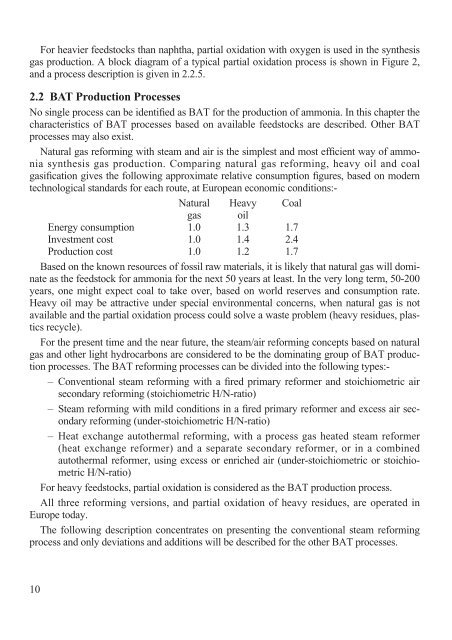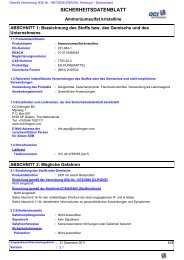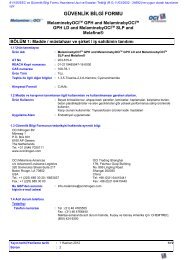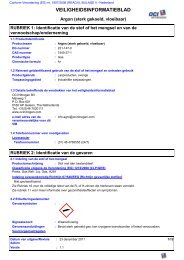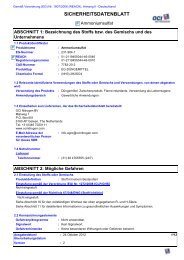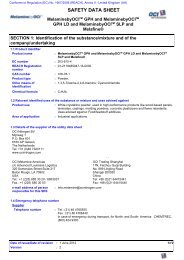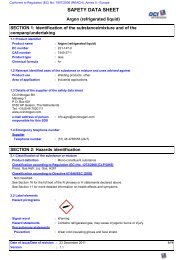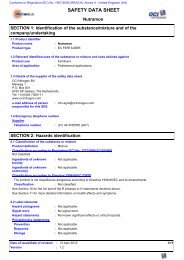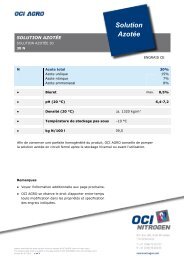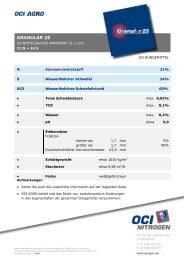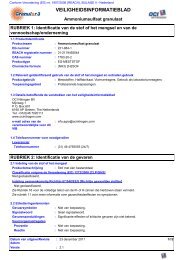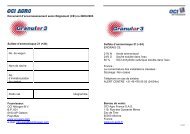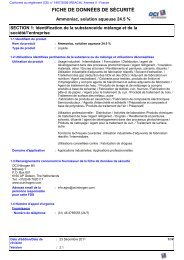PRODUCTION OF AMMONIA - OCI Nitrogen
PRODUCTION OF AMMONIA - OCI Nitrogen
PRODUCTION OF AMMONIA - OCI Nitrogen
Create successful ePaper yourself
Turn your PDF publications into a flip-book with our unique Google optimized e-Paper software.
For heavier feedstocks than naphtha, partial oxidation with oxygen is used in the synthesis<br />
gas production. A block diagram of a typical partial oxidation process is shown in Figure 2,<br />
and a process description is given in 2.2.5.<br />
2.2 BAT Production Processes<br />
No single process can be identified as BAT for the production of ammonia. In this chapter the<br />
characteristics of BAT processes based on available feedstocks are described. Other BAT<br />
processes may also exist.<br />
Natural gas reforming with steam and air is the simplest and most efficient way of ammonia<br />
synthesis gas production. Comparing natural gas reforming, heavy oil and coal<br />
gasification gives the following approximate relative consumption figures, based on modern<br />
technological standards for each route, at European economic conditions:-<br />
Natural Heavy Coal<br />
gas oil<br />
Energy consumption 1.0 1.3 1.7<br />
Investment cost 1.0 1.4 2.4<br />
Production cost 1.0 1.2 1.7<br />
Based on the known resources of fossil raw materials, it is likely that natural gas will dominate<br />
as the feedstock for ammonia for the next 50 years at least. In the very long term, 50-200<br />
years, one might expect coal to take over, based on world reserves and consumption rate.<br />
Heavy oil may be attractive under special environmental concerns, when natural gas is not<br />
available and the partial oxidation process could solve a waste problem (heavy residues, plastics<br />
recycle).<br />
For the present time and the near future, the steam/air reforming concepts based on natural<br />
gas and other light hydrocarbons are considered to be the dominating group of BAT production<br />
processes. The BAT reforming processes can be divided into the following types:-<br />
– Conventional steam reforming with a fired primary reformer and stoichiometric air<br />
secondary reforming (stoichiometric H/N-ratio)<br />
– Steam reforming with mild conditions in a fired primary reformer and excess air secondary<br />
reforming (under-stoichiometric H/N-ratio)<br />
– Heat exchange autothermal reforming, with a process gas heated steam reformer<br />
(heat exchange reformer) and a separate secondary reformer, or in a combined<br />
autothermal reformer, using excess or enriched air (under-stoichiometric or stoichiometric<br />
H/N-ratio)<br />
For heavy feedstocks, partial oxidation is considered as the BAT production process.<br />
All three reforming versions, and partial oxidation of heavy residues, are operated in<br />
Europe today.<br />
The following description concentrates on presenting the conventional steam reforming<br />
process and only deviations and additions will be described for the other BAT processes.<br />
10


